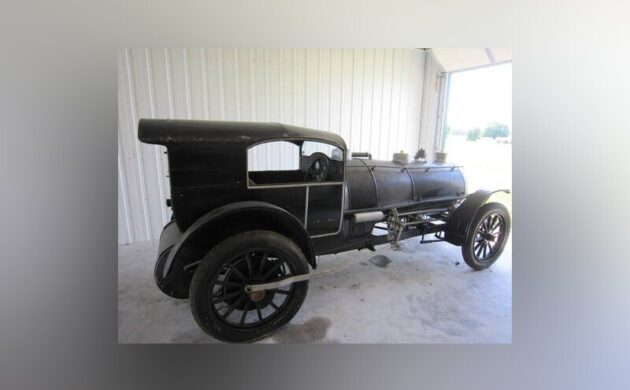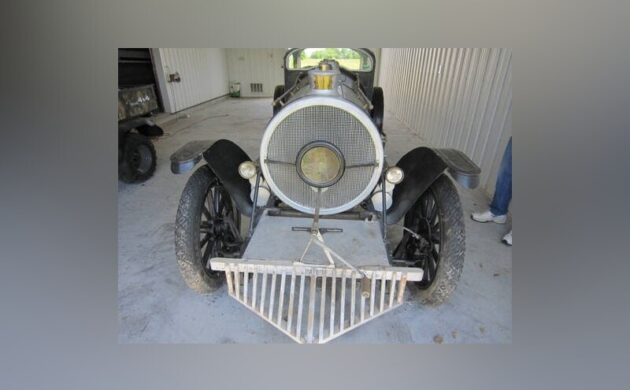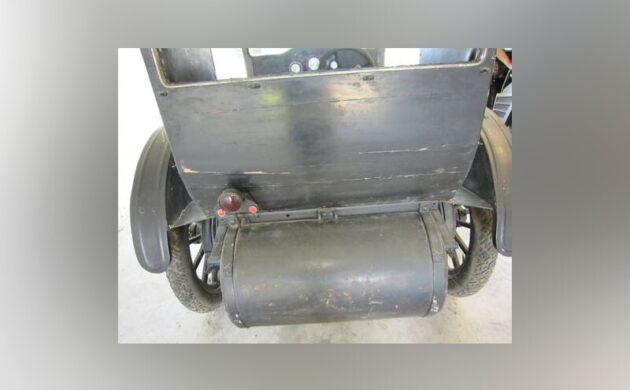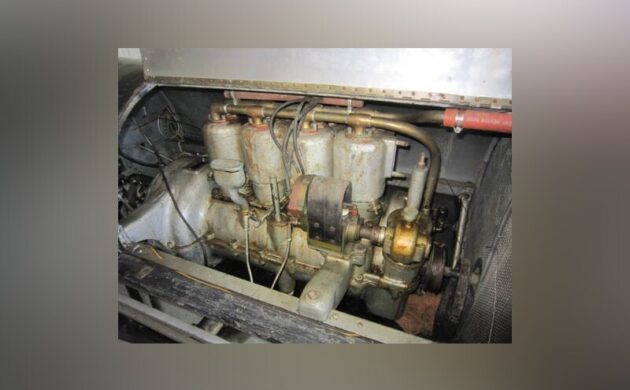Somehow, Barn Finds ends up profiling some of the more unusual cars on the collectible market. Perhaps it is because we don’t take ourselves too seriously. Often, these strange cars are built to promote a business or imitate another form of transportation. Nearly all are from the postwar period, but this one is different. Way different. Take a long look at this 1902 Sterand locomotive car for sale on carandclassic.com in Neosho, Missouri. This very old and quite unusual train themed car is so out there that no firm price has been established. One must make an offer. Are you interested? Would you take it on the London to Brighton Veteran Car Run? Believe it or not, it is eligible! Thanks to Kyle K. for this highly unusual find!
Let’s start with the ad. This vehicle is for sale by a classic car dealer Lost N the 50s Classic Cars. The ad states that this vehicle is one of just one built. It is powered by a four-cylinder engine putting out forty horsepower. This engine was built by a company called Rutenber and runs on gasoline. It is described as having numerous locomotive features such as a cowcatcher, bell, single head light, sand dome, and smokestack. It comes with an 8 day rim wind clock and has a transmission with two forward gears and reverse was thrown in for free. This locomotive car has just 12,000 miles on the odometer and was on its third owner.
As you can imagine, this is not an easy vehicle to find information on. It is the kind of vehicle that ended up on the back page of Hemmings Motor News’s brilliant companion publication known as Special Interest Autos. SIA was the greatest car magazine ever. The staff actually tracked down a number of automobile industry luminaries and interviewed them as part of their write ups. The write ups were not just reviews, but complete pieces about the development of the featured automobiles. As a humorous way to end the magazine, each time they had 2-4 picture and paragraph combos displaying odd vehicles and one-offs. A lot of these were vehicles customized to advertise a business.
That is where the next piece of the puzzle on this car comes in. Searching on the internet, I found this post card on the virtualsteamcarmuseum.org website. The card says that the Sterand Loco was built for the Chicago Soder Company by the Western Motor Car Company of Marion, Indiana. It goes on to state that the four-cylinder Rutenber engine puts out 15.6 horsepower. Furthermore, the pistons on the side of the engine are, in fact, air compressors. These are used to blow the whistle and air up the tires if the need arises. The dash has a 300-psi air gauge, an 8-day rim wind clock, and a speedometer that reads up to the car’s top speed of sixty miles per hour.
The engine is also pretty unusual. Rutenber engines were made by the Western Motor Company and named for the founder, Edwin Rutenber. The company primarily built four- and six-cylinder engines for small car companies like Nyberg, Moon, and Stoddard-Dayton. The Indianapolis Race (At the Indianapolis Speedway, but not the 500) was won in 1909 by Stoddard-Dayton using a Rutenber engine. This company soldiered on until around 1933, when it appears to have disappeared.
In all, you probably couldn’t find a more unusual vehicle. How this design sold solder is beyond me, but the company must have wanted it for some reason. The ad does not state whether it runs or not, but I am sure there is someone out there that could get this beast running. From there, it would be a lot of fun to drive. Its age even makes it eligible for the famous London to Brighton Veteran Car Run. Just imagine the delightful horror of this locomotive car blowing its whistle as it rapidly chugs by the dainty, carriage like cars typically seen in that event!
Would you like to have this locomotive car in your garage? What would you do with it?






Well, Jeff, you had me and you lost me. I thought, perhaps, this was an actual steam locomotive, which happen to fascinate me, adapted for automotive use, but tis’ not. I realize, there was an infatuation with locomotives around the turn of that century, but train based cars are corny and serve no purpose except a ride for the kids. For 1902,it really is surprisingly modern. I don’t see a differential, but I doubt it’s propelled by those side arms to the wheels. Maybe, and 60mph? In 1902 TEN miles an hour was flying, so no way,especially if it IS driven by those arms. It’s a fun find.
This looks like something Harley Davidson would make:-)
I’m suspicious of the 1902 date. The various components give off a vibe that is at least 10 years later than that
The New London/New Brighton car run goes right past the bar where I work in the summer. Lots of old timers stop in for lunch and a beer; always fun to see the old iron.
Good Grief! This is a fake steam car, powered by a 4 cylinder gas engine. There is a magneto clearly shown in one photo. No sign of a boiler or smoke stack.
This 1902 (yeah) Sternad was built by A. F. Sternad in 1917. Although he spent four years and an enormous sum, $ 10,000, it most certainly was never claimed to be anything other than Sternard’s amazing 1917 toy by the man who engineered (pun intended) it.
The Old Motor dot com article from 2014 has photos and a short 1921 Pathé film titled “A Motor Novelty (1921)”:
https://theoldmotor.com/?p=130145
Listing this novelty car on the UK based car and classic dot com site is a bit off the rails…
A dose of reality is always refreshing, especially when something comes across this site which I have zero knowledge about.
Thank you, James.
I would love to see anyone present this to the dating commitee of the Veteran Car Club as a 1902.
What would follow would be a public humiliation so excrutiating that only an English public school toff could deliver it.
There is nothing here which is from 1902, though maybe some components from 1915 onwards. I have no idea what it is, other than someone´s private joke.
Its uhhh….automobilia!
Unusual that’s for sure!!!!!!!!!!!
Built in 1917 – that’s more like it. This thing looks like it would be an absolute hoot to drive around in! I would build a lightweight trailer done to resemble a Pullman car or a coal-tender to tow behind it.
I would love to ride my bicycle from London to Brighton on the day they do the run.
I watched the L to B run from a little village called Staplefield a couple of year ago and a guy came past on a steam powered tricycle! He was going like a train as well. It was only about 15 miles from Brighton so I assume that he made the finish in time.
One of the items on the original “bucket list” I created about 55 years ago*, was to be a spectator along the London to Brighton run. Then when I was able to do so in 1987, I changed the goal to entering a vehicle in the Brighton run! About 20 years ago it looked like I might get the chance to participate, riding in a very early Packard. However the car and it’s owner never did make it to England for the run.
Now at my age & with failing health, I know that’s not gonna happen, even if I had the money to do it. At this point I would gladly settle with just riding in one of the cars during the run, even if it was only on part of the trip.
As I was reading the write up and looking at the photos, like others who have already stated here, I came to the obvious conclusion that this interesting and quirky vehicle was made a decade or more later than 1905, the cut-off date for the Brighton run. The process of getting a vehicle approved for the London to Brighton run is very involved, and one must be able to prove that a vehicle was indeed made prior to the date of the original 1905 run. For vehicles that were considered part of a production run that began earlier than the cut-off date, that’s not too difficult. However if it’s a recently discovered car or an already known car without provenance, if an owner cannot prove the car existed prior to the cut-off date, It simply won’t be allowed.
*For many years I’ve been telling young people to create their own “bucket list” My original list of “Things to do before I die” was created when I was about 13 to 15 years of age, and from the start I decided it was a fluid list, subject to change.
For example, the original list had “Sit in a Rolls-Royce”. That was too easy, so it became “Drive a Rolls-Royce”. Then “Own a Rolls-Royce”, then :”Own a pre-war Rolls-Royce”.
I gave up modifying the Rolls-Royce catagory when about 15 years ago I was allowed to sit in, then drive [a few feet forward] the actual Rolls-Royce Silver Ghost, said to be the most valuable automobile in the world. [See photo] I figured there was no way I was going to top that experience!
You’re so lucky Bill. I have seen it a couple of times and it truly is a magnificent piece of automobile engineering excellence. I would just like to get close enough to touch/feel it and then take numerous close up photographs of it.Drive it? Not on your life. Imagine pranging it! The world would never forgive me.
“Drive it? Not on your life. Imagine pranging it! The world would never forgive me.”
Note that I was allowed to drive it only about a Meter. The intent was so I could honestly say I had driven the Silver Ghost, but not in a manner where it might risk being damaged.
The back story;
In the late 1960s while still in high school, I used to hang around and help out [sweeping floors, etc.] at a small antique car restoration shop run by 2 men; Bill F. and Bruce D. Bill was considerably older and had worked his way up to the position as service manager at a large Packard dealership, and he had restored many classic era cars. Bruce was about 20 years older than me, and specialized in Rolls-Royces & Bentleys. I learned a lot from these 2 men over about 2 years.
It was these 2 guys who gave me the confidence to start my own restoration shop years later. Bruce went on to become the Rolls-Royce & Bentley service manager at one of America’s larger Rolls-Royce dealerships, in Bethesda, MD. We stayed in touch over the years, and I used to sit in on his factory service seminars when ever possible. When Bruce decided to sell his 1932 Rolls-Royce 20/25 Hooper bodied sport saloon, he called me first, and I ended up with the car.
Fast forward to around 20 years ago, and I was now retired and had moved about an hour north to a small farm. Working on the floor of the new sunroom I was adding to my 1850 farmhouse, I was laying ceramic tile when Bruce called. He asked if I could come down to the dealership right away, and he told me to bring a camera with film [pre-smartphone with camera].
So I hopped into my truck and drove down to Bethesda. On my arrival he asked me to follow him, as we went out back & into the dealership’s 3-level parking garage. In a very protected area of the garage sat a large vehicle convered with a fleece car cover. On removing the cover, I immediately recognized the Silver Ghost, with it’s famous British license plate AX 201. Bruce took me on an all-to-brief ride, before taking my camera and telling me to sit in the diver’s seat. That’s when he told me to drive it a few feet as he took the photo.
I assume everybody is aware of the 1953 movie Genevieve about the London to Brighton run.
Here’s the trailer:
https://www.youtube.com/watch?v=6BdlRqo64ZU
The whole thing is on YouTube
It’s generally accepted that this movie, Genevieve, started the world-wide fascination with collecting old cars and bikes. As far as South Africa is concerned a Dr. Dick Coller was holidaying in UK when the film came out and was so impressed that he bought a 1905 Mors and exported it back home to SA. He then had a small interview published in the local Natal Mercury daily newspaper and asked for interested persons to meet the following Saturday at a Durban hotel. Fifteen people signed up to form the Veteran Car Club of SA and it has now been going since 1954 and every South African old car club, of which there are about 50, is an offshoot of that meeting.
WottheHell…………………
No “Locomobile” jokes?!?
This crowd must not be old enough yet!
And what about “Alco”, for that matter?!?
The few American Locomotive Co. cars are considerably rarer and more unknown than Locomobiles.
In my spare time I restore vintage timepieces. Occasionally I’ll get a automobile clock that is electric. The clock in the description is like a super pocket watch. I have never heard of a 8 day reserve after a full wind, especially 1902. I’ll have to research more on that horological subject. jv – smash palace
Answering my own question.. its actually a Phinney Walker 8 day clock, manual winder.
jv – smash palace
https://m.facebook.com/groups/565767180190716/permalink/5491359997631385/
I found many period newspaper clippings about the car in the teens and twenties and presented them and the accurate story of the car to the seller and he didn’t seem to want to believe it.
Rutenber didn’t make engines in Marion Indiana until the beginning of 1910 so with Marion cast right on the side of the engine it has to be from 1910 or newer. Also the Chicago Solder company who it was “built for” was known as the Kester Electric manufacturing company until January 1905, when it became Chicago solder.
Great info, guys. Thanks!
Made to advertise a soder company? It would have done much better to advertise a funeral home as it looks exactly like a chopped old-timey hearse.